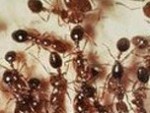 The aggressive behavior and painful sting of the red imported fire ant (RIFA) makes it an unwelcome guest in gardens, woods, and fields. In addition to the pain the RIFA can inflict on humans it causes considerable damage to crops as well as livestock and can bring about serious damage to electrical systems resulting in short circuits and fires. Once in an area the RIFA is almost impossible to eradicate but can be controlled.
The aggressive behavior and painful sting of the red imported fire ant (RIFA) makes it an unwelcome guest in gardens, woods, and fields. In addition to the pain the RIFA can inflict on humans it causes considerable damage to crops as well as livestock and can bring about serious damage to electrical systems resulting in short circuits and fires. Once in an area the RIFA is almost impossible to eradicate but can be controlled.
1. RIFA was introduced from South America into the port of Mobile, Alabama in the 1830s probably in soil used as ballast. It can live in areas with temperatures above 10o F. and rainfall greater than 10 inches per year so has spread throughout much of the southern United States. Because of global warming it is likely to spread further north in future years.
2. Fire ants, unlike most other ants, both bite and sting. They grab onto their victim with their mouth parts and then inject venom from their abdomen. This venom causes a burning and itching sensation followed by the formation of white pustules that remain for several weeks. A small percent of the human population is allergic to the venom and may die. To make matters worse, the ant attacks are coordinated so that hundreds of workers all sting at the same time.
3. Insects, ticks, seeds, seedlings, young trees, plant buds, and fruits are favorite foods of the IRFA.
4. The presence of the RIFA may first be noticed by dome-shaped mounds of loose soil-like material up to 24 inches tall and 18 inches wide. They are usually located in sunny moist areas but in undisturbed areas nests may be located under such objects as logs, rocks, sidewalks, and building walls. They extend down to 5 feet deep, have no visible entrance, but have numerous subterranean tunnels extending from the central mound.
5. Single colony may have 100,000 to 500,000 ants of various sizes and includes a queen, drones, and workers. The workers are sterile females.
6. Winged male and female ants mate in mid-air during the spring and summer. The males die and the females form new colonies. Male ants live only 4-5 days.
7. The queen can produce up to 3,500 eggs per day which is about 9 million eggs in her life time of 6-7 years. Each nest has one or more queens.
8. Unlike other ants, RIFAs are invasive due to their aggressive nature and lack of natural enemies.
9. In spite of their harmful ways, RIFAs have some virtues. They are natural predators of several pests including the rice stink bug, boll weevil, cotton leafworm, soybean looper, sugarcane borer and aphids. But, yes, they also parasitize beneficial insects.
10. The least toxic way of controlling RIFA is by pouring boiling water into each nest. The trick is to kill the queen/s so that egg production stops and this is difficult if not impossible so repeated treatment will be necessary. For large infestations, use ant bait insecticides such as hydramethylnon. They work slowly over a period of weeks but are relatively inexpensive and environmentally safe.
As when dealing with any introduced species, care must be taken when trying to manage it. The same chemical that kill RIFA also kill other ants that are beneficial in the garden. Positive identification of RIFAs and enlisting the aid of professional agricultural experts such as county extension agents are important steps in controlling this menace in a responsible and safe manner.